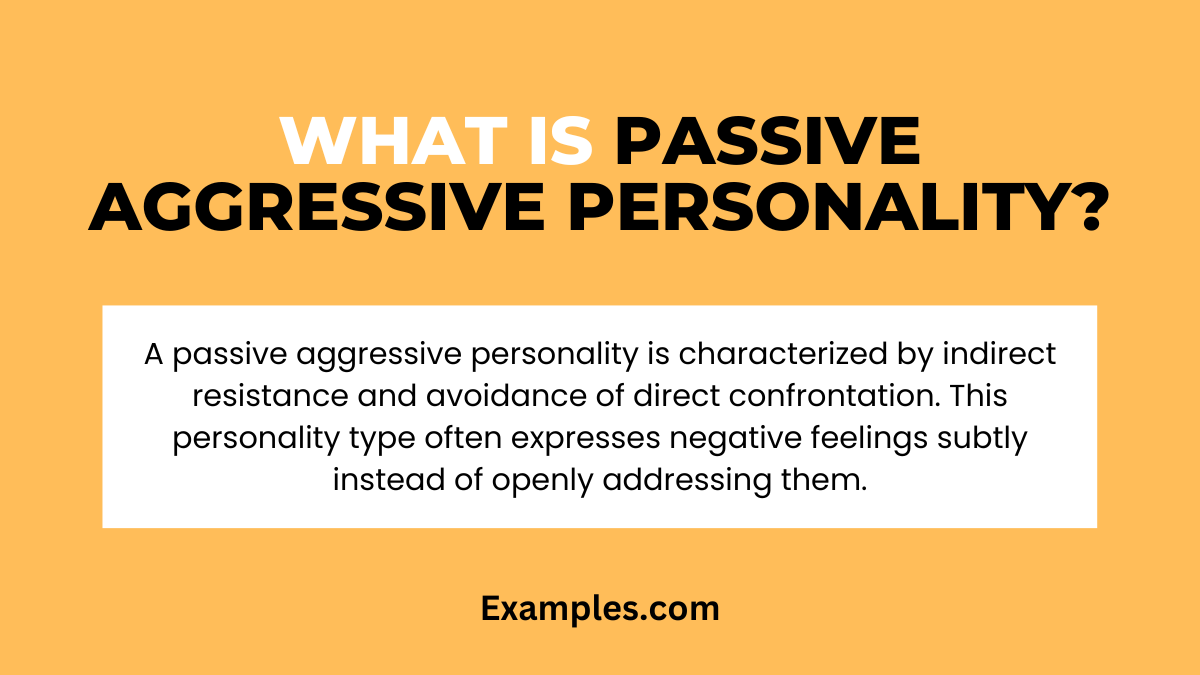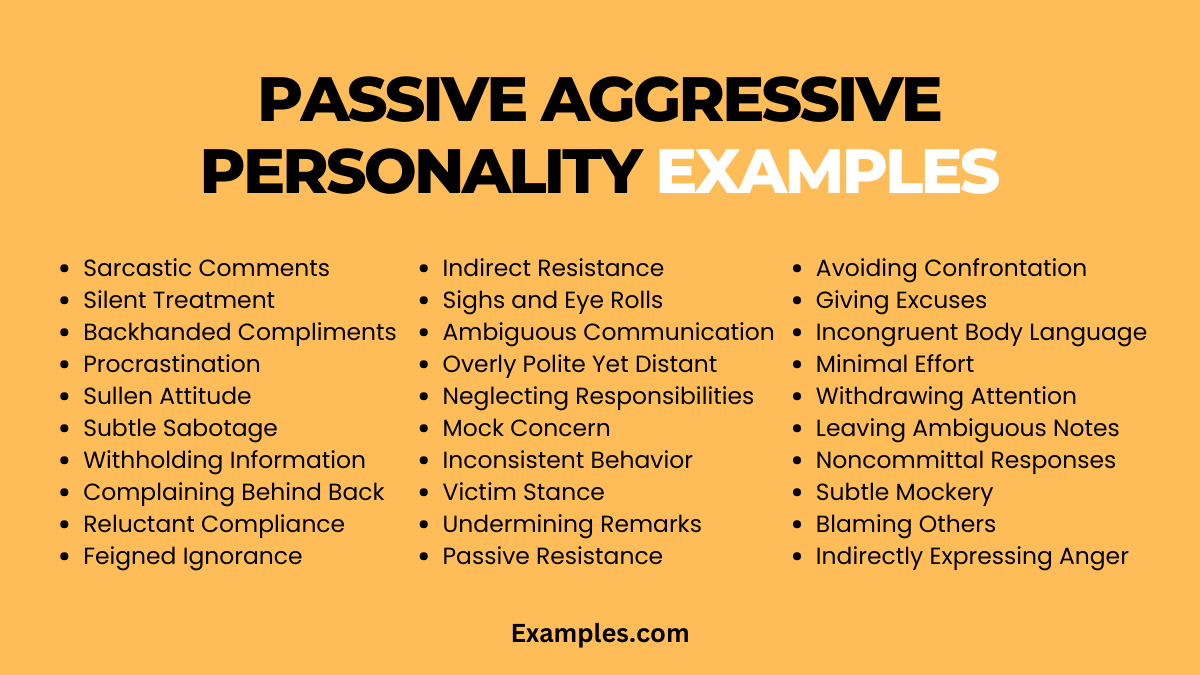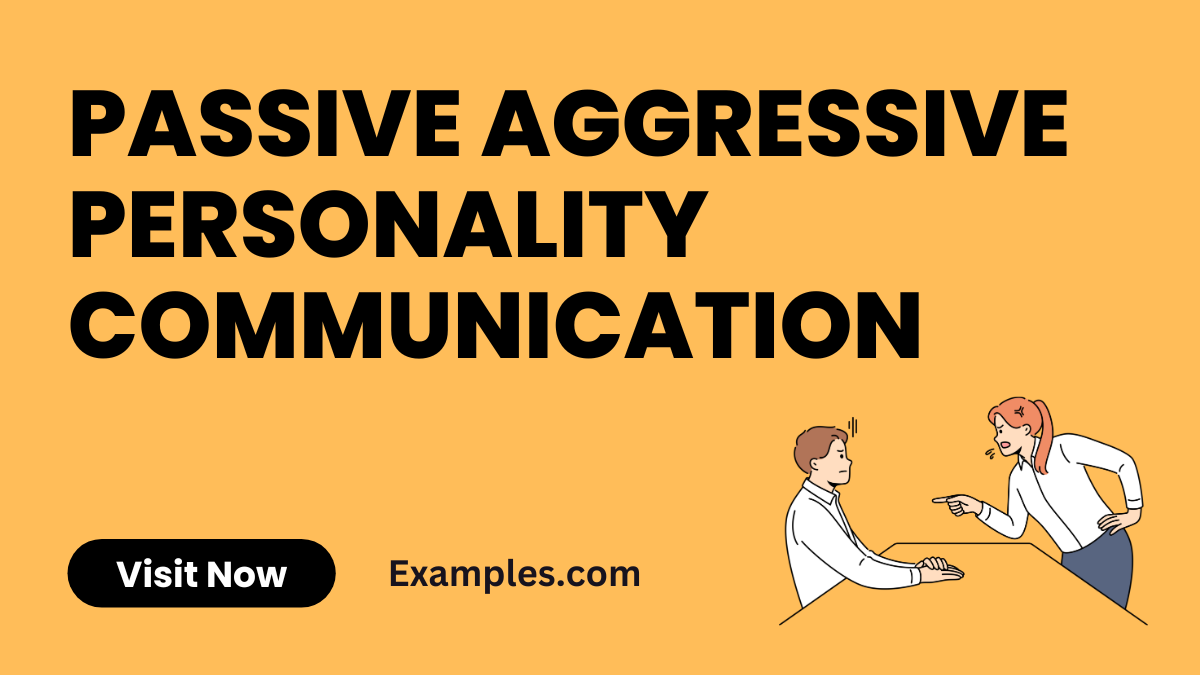29+ Passive Aggressive Personality Examples
Dive into the intricate world of passive-aggressive personality with our all-encompassing guide. This article provides a deep understanding of the subtle yet impactful traits of passive-aggressive behavior. From everyday communication examples to expert insights, learn how this personality type affects interactions in various settings. Whether it’s in personal relationships or professional environments, our guide offers valuable strategies for recognizing and effectively dealing with passive-aggressive tendencies. Stay ahead in understanding complex interpersonal dynamics with this essential read.
What is Passive Aggressive Personality?

A passive aggressive personality is characterized by indirect resistance and avoidance of direct confrontation. This personality type often expresses negative feelings subtly instead of openly addressing them. Key traits include procrastination, sullen behavior, stubbornness, and a failure to communicate grievances directly. People with this personality often feel powerless or resentful, leading to these indirect expressions of anger and frustration. It’s a coping mechanism that can hinder effective communication and relationships.
30 Passive Aggressive Personality Examples

Passive-aggressive personalities often manifest through indirect communication and actions that subtly express negativity. These behaviors can be challenging to identify and address, as they are often cloaked in superficial politeness or non-confrontational attitudes. Understanding these examples can help in recognizing and effectively managing passive-aggressive tendencies in various settings.
- Sarcastic Comments: Making a seemingly humorous but actually critical remark about someone’s work in a meeting.
- Silent Treatment: Deliberately ignoring or avoiding someone as a form of punishment or to express disapproval.
- Backhanded Compliments: Complimenting someone in a way that also insults or belittles them.
- Procrastination: Intentionally delaying tasks as a form of resistance or to show disapproval.
- Sullen Attitude: Displaying a consistently moody or sulky demeanor, especially in response to requests or expectations.
- Subtle Sabotage: Intentionally making small mistakes or omissions to undermine a project or task.
- Withholding Information: Purposely not sharing important information as a way to exert control or cause inconvenience.
- Complaining Behind Someone’s Back: Expressing negative opinions or complaints about someone to others instead of addressing the person directly.
- Reluctant Compliance: Agreeing to do something but with evident unwillingness or minimal effort.
- Feigned Ignorance: Pretending not to understand instructions or requests as a means of avoiding responsibility.
- Indirect Resistance: Not openly refusing a request, but not following through with it either.
- Sighs and Eye Rolls: Using nonverbal cues to express disagreement or disdain without verbal confrontation.
- Ambiguous Communication: Giving vague or non-committal responses to avoid direct answers.
- Overly Polite Yet Distant: Being excessively polite in a way that feels insincere and creates emotional distance.
- Neglecting Responsibilities: Ignoring or not fulfilling responsibilities to express discontent or opposition.
- Mock Concern: Expressing concern in a way that is actually critical or belittling.
- Inconsistent Behavior: Acting friendly in person but hostile or negative behind someone’s back.
- Victim Stance: Portraying oneself as the victim to avoid responsibility and gain sympathy or manipulate a situation.
- Undermining Remarks: Making comments that subtly undermine someone’s confidence or position.
- Passive Resistance: Not openly opposing a plan or idea but not supporting or engaging with it either.
- Avoiding Direct Confrontation: Consistently avoiding direct discussions or confrontations about issues.
- Giving Excuses: Regularly offering excuses for not meeting expectations or commitments.
- Incongruent Body Language: Body language that contradicts verbal communication, indicating hidden displeasure or disagreement.
- Minimal Effort: Doing the bare minimum required, without enthusiasm or engagement.
- Withdrawing Affection or Attention: Intentionally withholding affection or attention as a form of manipulation or control.
- Leaving Ambiguous Notes: Communicating through notes or messages that are vague and open to interpretation.
- Noncommittal Responses: Giving responses that don’t commit to a clear answer or position.
- Subtle Mockery: Mocking or making fun of someone in a subtle, indirect way.
- Blaming Others: Consistently blaming others for one’s own failures or shortcomings.
- Indirectly Expressing Anger: Expressing anger or displeasure through actions, such as slamming doors, rather than through words.
What are Passive Aggressive Personality Disorder Symptoms?
Understanding passive-aggressive behavior involves recognizing various subtle actions and attitudes that indirectly express resistance or discontent. Here’s an expanded look at some key behaviors:
- Indirect Resistance to Demands: This behavior involves subtly resisting requests or demands without openly refusing them. It’s a way of saying no without actually saying it, often leading to frustration in others who may not understand the reason for the non-compliance.
- Procrastination and Intentional Mistakes: A common passive-aggressive tactic is deliberately delaying tasks or performing them poorly. This can be a way of expressing displeasure or disagreement with the task or the person who assigned it, without verbalizing these feelings.
- Cynical Attitude: Displaying a consistently negative and skeptical view of situations is another sign. This attitude often serves as a defensive mechanism, protecting the individual from disappointment but also creating a barrier to positive experiences and interactions.
- Sullen Behavior: Frequent moodiness or sulking can be indicative of passive-aggressive behavior. This often reflects an underlying dissatisfaction or resentment that the person feels unable to express directly.
- Frequent Complaining: Complaining about being misunderstood or underappreciated, especially without directly addressing the issues with the concerned parties, is a hallmark of passive-aggressive behavior. It’s a way of voicing displeasure while avoiding direct confrontation.
- Blaming Others: Shifting responsibility and blaming others for their own failures or shortcomings allows individuals to avoid accountability. This behavior not only hinders personal growth but can also strain relationships and create a toxic environment.
Recognizing these behaviors is the first step in addressing and managing passive-aggressive communication effectively. It’s important to approach such situations with understanding and patience, while also setting clear boundaries and expectations for healthy communication.
What are the Causes of Passive-Aggressive Personality?
Passive-aggressive behavior often has its roots in childhood experiences and learned behavior, alongside underlying resentment and cultural influences.
- Childhood Experiences: Growing up in an environment where direct expression of emotions is discouraged or punished can lead individuals to develop passive-aggressive tendencies. In such settings, openly expressing feelings, especially negative ones, might have been met with negative reactions, leading children to find indirect ways to communicate their emotions.
- Learned Behavior: Passive-aggressiveness can also be a learned behavior, adopted as a coping mechanism. If an individual observes and internalizes this communication style from family members or significant others during their formative years, it can become their go-to method for handling conflicts and expressing dissatisfaction.
- Underlying Resentment: Often, passive-aggressive behavior stems from unresolved feelings of resentment, inadequacy, or frustration. These feelings may be rooted in past experiences or current situations where individuals feel powerless or unheard. Instead of addressing these feelings directly, they may resort to passive-aggressive behaviors as a way of expressing their discontent.
- Cultural Influences: Societal norms and cultural backgrounds play a significant role in shaping communication styles. In some cultures, openly expressing negative emotions or confrontations is frowned upon, leading individuals to adopt a more indirect approach. Passive-aggressive behavior in such contexts is a way to conform to these cultural expectations while still expressing personal grievances.
Understanding these underlying factors is crucial for effectively addressing and modifying passive-aggressive behavior. Recognizing the root causes can also aid in developing healthier communication strategies.
How to Identify Passive-Aggressive Personality?
Passive-aggressive behavior manifests in various forms:
- Subtle Resistance: This involves indirectly resisting requests or demands, often through procrastination or by providing excuses, thereby avoiding overt refusal while still not complying.
- Avoidance of Direct Communication: Individuals may use indirect methods to express displeasure or disagreement, such as hinting or using ambiguous language, rather than stating their issues openly.
- Chronic Procrastination: Consistently delaying tasks can be a passive-aggressive tactic to avoid obligations or express covert opposition.
- Sarcasm and Backhanded Compliments: This includes using sarcasm or giving compliments that actually contain subtle insults, allowing the person to express negativity under the guise of humor or politeness.
- Hostility Masked as Jokes: Expressing negative feelings or criticism through humor is a common passive-aggressive behavior, where true feelings are veiled as jokes to avoid direct confrontation.
Understanding these behaviors is key to recognizing and addressing passive-aggressive communication effectively.
How to Treat Passive Aggressive Personality Disorder?
Treating passive-aggressive behavior can be multifaceted, involving therapy, communication training, stress management, self-esteem building, and sometimes medication.
- Therapy: Psychological counseling, such as cognitive-behavioral therapy (CBT), is effective in helping individuals understand and modify their behavior patterns. CBT focuses on identifying and changing negative thought patterns and behaviors.
- Communication Training: This involves learning and practicing effective communication skills to express feelings and needs directly, which is crucial for overcoming passive-aggressive tendencies.
- Stress Management: Implementing stress management techniques, such as mindfulness or relaxation exercises, can significantly reduce passive-aggressive reactions by managing underlying stress.
- Building Self-Esteem: Engaging in activities that boost self-confidence and self-worth can help individuals feel more secure, reducing the need for passive-aggressive behaviors.
- Medication: In some cases, medication might be prescribed to treat underlying mental health issues like anxiety or depression, which can contribute to passive-aggressive behavior.
Addressing passive-aggressive behavior often requires a combination of these approaches for effective treatment and behavior change.
Tips for Dealing with Passive Aggressive Personality

When dealing with someone who has a passive-aggressive personality, consider these tips:
- When dealing with passive-aggressive behavior, it’s important to employ strategies that promote healthy communication and relationship dynamics. Here’s an expanded view of the key approaches:
- Maintain Patience: It’s essential to recognize that altering deep-seated communication patterns takes time. Patience is crucial in this process. Understand that the individual exhibiting passive-aggressive behavior might not immediately grasp or accept their communication style’s impact. Consistent, patient support and reinforcement of positive communication practices can gradually encourage change.
- Open Communication: Fostering an environment where open and honest dialogue is encouraged can help break the cycle of passive-aggressive communication. This involves creating a safe space where feelings and thoughts can be expressed freely and without judgment. Encourage the individual to share their true feelings and needs, and respond with understanding and validation.
- Set Boundaries: Clearly defining what behaviors are acceptable and what consequences follow if those boundaries are crossed is vital. This helps in establishing respect and mutual understanding in the relationship. Boundaries should be communicated clearly and enforced consistently, ensuring that passive-aggressive behaviors are not inadvertently reinforced.
- Avoid Power Struggles: Engaging in conflicts or power struggles with someone exhibiting passive-aggressive behavior can often exacerbate the issue. It’s important to approach such situations calmly and refrain from reacting defensively. Instead, focus on constructive problem-solving and avoid getting drawn into unproductive arguments.
- Empathy: Demonstrating empathy involves trying to understand the individual’s perspective and underlying feelings. Acknowledge that their behavior likely stems from past experiences or unmet needs. Showing empathy can build trust and open the door to more effective communication
Navigating a relationship with a passive-aggressive individual requires understanding, clear communication, and setting healthy boundaries.
In conclusion, understanding and addressing passive-aggressive personality traits are crucial in fostering healthier communication. Recognizing patterns like indirect anger expression and avoiding confrontation helps identify passive-aggressiveness. Addressing these behaviors through open communication and professional guidance can lead to more direct, constructive interactions, benefiting personal and professional relationships.



